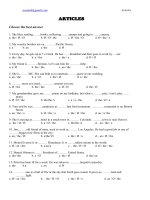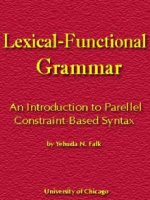Lexical approach article
Bạn đang xem bản rút gọn của tài liệu. Xem và tải ngay bản đầy đủ của tài liệu tại đây (122.68 KB, 5 trang )
Grammar vs. lexis or grammar through lexis?
By Leo Selivan
This article was first published in September 2011
In this article, informed by the Lexical Approach, I reflect on grammar instruction in the
classroom, including my own teaching, and make suggestions on how it can be
'lexicalised'. I consider the problems with 'traditional' grammar teaching before arguing
that what we actually need is more grammar input as well as showing how lexis can
provide necessary 'crutches' for the learner.
For more on the Lexical Approach see other articles on the TE website:
•
•
/> />
Lexis = vocabulary + grammar
The shift in ELT from grammar to lexis mirrors a similar change in the attitude of
linguists. In the past linguists were preoccupied with the grammar of language; however
the advances in corpus linguistics have pushed lexis to the forefront. The term 'lexis',
which was traditionally used by linguists, is a common word these days and frequently
used even in textbooks.
Why use a technical term borrowed from the realm of linguistics instead of the word
'vocabulary'? Quite simply because vocabulary is typically seen as individual words
(often presented in lists) whereas lexis is a somewhat wider concept and consists of
collocations, chunks and formulaic expressions. It also includes certain patterns that
were traditionally associated with the grammar of a language, e.g. If I were you…, I
haven’t seen you for ages etc.
Recognising certain grammar structures as lexical items means that they can be
introduced much earlier, without structural analysis or elaboration. Indeed, since the
concept of notions and functions made its way into language teaching, particularly as
Communicative Language Teaching (CLT) gained prominence, some structures
associated with grammar started to be taught lexically (or functionally). I’d like to is not
taught as 'the conditional' but as a chunk expressing desire. Similarly many other
'traditional' grammar items can be introduced lexically relatively early on.
Less grammar or more grammar?
You are, no doubt, all familiar with students who on one hand seem to know the 'rules'
of grammar but still fail to produce grammatically correct sentences when speaking or,
on the other, sound unnatural and foreign-like even when their sentences are
grammatically correct. Michael Lewis, who might be considered the founder of the
Lexical Approach, once claimed that there was no direct relationship between the
knowledge of grammar and speaking. In contrast, the knowledge of formulaic language
has been shown by research to have a significant bearing on the natural language
production.
Furthermore, certain grammar rules are practically impossible to learn. Dave Willis
cites the grammar of orientation (which includes the notoriously difficult present perfect
and the uses of certain modal verbs) as particularly resistant to teaching. The only way
to grasp their meaning is through continuous exposure and use.
Finally, even the most authoritative English grammars never claim to provide a
comprehensive description of all the grammar, hence the word 'introduction' often used
in their titles (for instance, Huddleston & Pullum’s A Student's Introduction to English
Grammar or Halliday’s An Introduction to Functional Grammar).
If grammarians do not even attempt to address all areas of grammar, how can we,
practitioners, cover all the aspects of grammar in our teaching, especially if all we seem
to focus on is a limited selection of discrete items, comprised mostly of tenses and a
handful of modal verbs? It would seem that we need to expose our students to a lot of
naturally occurring language and frequently draw their attention to various grammar
points as they arise.
For example, while teaching the expression fall asleep / be asleep you can ask your
students:
• Don’t make any noise – she’s fallen asleep.
Don’t make any noise – she’s asleep.
What does ‘s stand for in each of these cases (is or has)?
One of the fathers of the Communicative Language Teaching Henry Widdowson
advocated using lexical items as a starting point and then 'showing how they need to be
grammatically modified to be communicatively effective' (1990:95). For example, when
exploring a text with your students, you may come across a sentence like this:
• They’ve been married for seven years.
You can ask your students: When did they get married? How should you change
the sentence if the couple you are talking about is no longer married?
The above demonstrates how the teacher should be constantly on the ball and take every
opportunity to draw students’ attention to grammar. Such short but frequent 'grammar
spots' will help to slowly raise students’ awareness and build their understanding of the
English grammar system.
Grammar after lexis
English lessons in a Primary school involve teaching a lot of chunks, such as Good
morning. How are you? Where do you live? However, as learners get older they tend to
memorise less. They 'switch on' their analytical thinking and tend to break up the
language they encounter into constituent bits. Teaching materials that separate grammar
and vocabulary do not help either.
How can we assist learners in building a grammar system and, at the same time, help
them crack some 'unlearnable' rules? Once again the key is to start with examples of
language in use presented as whole chunks without spending too much time on
structural analysis in the early stages of learning.
For example, the modal verb might with its daunting variety of uses such as deduction,
permission as well as being the past form of may is often followed by the verb take to
talk about time. It can therefore be presented as a chunk It might take a while without
attending formally to all possible uses of might.
Such memorised chunks will later promote grammar acquisition. Also, it is often easier
to generate similar sentences from ready-made examples rather than from formal rules.
Having memorized It might take a while, learners can later produce
It might take a long time
It might take a couple of weeks
It might take even longer
Consider another example. The memorized pattern he isn’t easy to live with can be
extended to:
isn’t easy to work with
isn’t easy to get on with
isn’t easy to deal with
or later
isn’t easy to talk to
Grammar through lexis
Once I was invited to be a guest speaker in a Primary school. The fifth-graders, who
must have just been taught question formation in the Past Simple, were firing questions
at me: ‘Did you go to Buckingham Palace?’, ‘Did you see the Queen?’ ‘Did you visit
the Tower of London’? While quite impressed with their knowledge of London sights
and architectural icons I could not help but think that one day they would have to relearn what they had been taught. In all of the above examples it would be more natural
to use the Present Perfect: Have you been to…? Have you seen…? etc. Surely there must
be a more natural way of practicing the Past Simple, for instance: Did you have a nice
weekend? What did you do? Did you stay at home all day?
Delaying the introduction of certain structures is an enduring legacy of structural syllabi
where learning a language, particularly its grammar system, was seen as itemistic. In
other words, gradually moving from an easier item to a more complex one, following a
linear sequence.
I remember teaching an Intermediate course using New Headway Intermediate, which
was still an unassailable authority in those days, and where the Present Perfect does not
appear until the second half of the coursebook. I too stand guilty of telling my students
that “they are not ready for it” because they have not fully mastered other tenses or
structures.
Unfortunately, many coursebooks still carefully grade the texts to avoid any encounters
with the structures that have not been formally taught. The practice of methodically
expunging what may be perceived as a difficult grammar point from textbooks for fear
that it might confuse the learner, is regrettable because it deprives our students of
natural examples they will later need to build their understanding of this point.
Learning a language is a cyclical process and full mastery takes a long time to achieve.
If we go back to our “would” example, this modal verb has a variety of uses. Apart from
expressing desire mentioned above, it can be used to talk about Future in the Past,
hypothetical or imaginary situations and past habits to name but a few.
Thus our elementary level students using “would like” to express desire do not have the
full mastery of this complex modal verb. Yet, it does not prevent them from using it
appropriately in certain situations, i.e. expressing desire. Likewise, many seemingly
difficult grammar structures can be introduced to talk about specific functions or
situations. Here are some more examples.
Present perfect
Rather than delaying it until the Intermediate Level, it can be introduced at the
Elementary level to talk about travel:
Have you been to London / Turkey / South America?
Later on, it can be expanded to the topic of films.
Have you seen Matrix 2?
Past perfect
It can be introduced as a chunk worse than I’d expected and later extended to than I’d
imagined / than I’d thought / than I’d anticipated.
These instances in no way account for all the complexities of the Present or Past Perfect
but they will contribute to the understanding of the concept in the later stages of
learning. Consequently, by the time learners have come to formally deal with these
structures they will have collected enough examples of them in use. Lengthy formal
explanations may thus become partially redundant because students will have already
internalised certain structures taught lexically.
Conclusion
So is there room for grammar instruction in the classroom? Certainly yes. But the
grammar practice should always start with the exploitation of lexical items. Exposing
students to a lot of natural and contextualised examples will offer a lexical way into the
grammar of the language.
To sum up, grammar should play some role in language teaching but should not occupy
a big part of class time. Instead grammar should be delivered in small but frequent
portions. Students should be encouraged to collect a lot of examples of a particular
structure before being invited to analyse it. Hence, analysis should be preceded by
synthesis.
Lastly, language practitioners should bear in mind that grammar acquisition is an
incremental process which requires frequent focus and refocus on the items already
studied.
References
•
Lewis, M. (1993). The Lexical Approach. The State of ELT and a Way Forward.
LTP
•
•
Willis, D. (2003). Rules, Patterns and Words. CUP
Widdowson, H. (1990). Aspects of Language Teaching. OUP
Also, although not referred to in the article, Hugh Dellar, one of the co-authors of the
Innovations series (published by Heinle-Cengage) has often expressed similar views on
the role of grammar and influenced my way of thinking.
•
Dellar, H. (2004) Grammar is dead! Long live grammar! The Language Teacher,
28(7), 29-31. retrieved from />









